BHO6505 Marketing Management: A Case Study on Optus Strategy
VerifiedAdded on 2023/06/03
|15
|3749
|94
Report
AI Summary
This report presents a comprehensive marketing plan for Optus, a major telecommunications company in Australia, aiming to expand its services internationally. It includes a situation analysis covering market summary, target market, market needs, trends, and growth, alongside a SWOT analysis identifying Optus's strengths, weaknesses, opportunities, and threats. The report also details the competitive landscape and key success factors, addressing critical issues such as licensing and brand presence. The proposed marketing strategy emphasizes service quality and speed, outlining the company's mission, marketing and financial objectives, target markets, positioning, and marketing mix strategies (product, price, promotion, and place). This analysis provides a framework for Optus to enhance its market position and achieve sustainable growth, and students can find similar resources on Desklib.
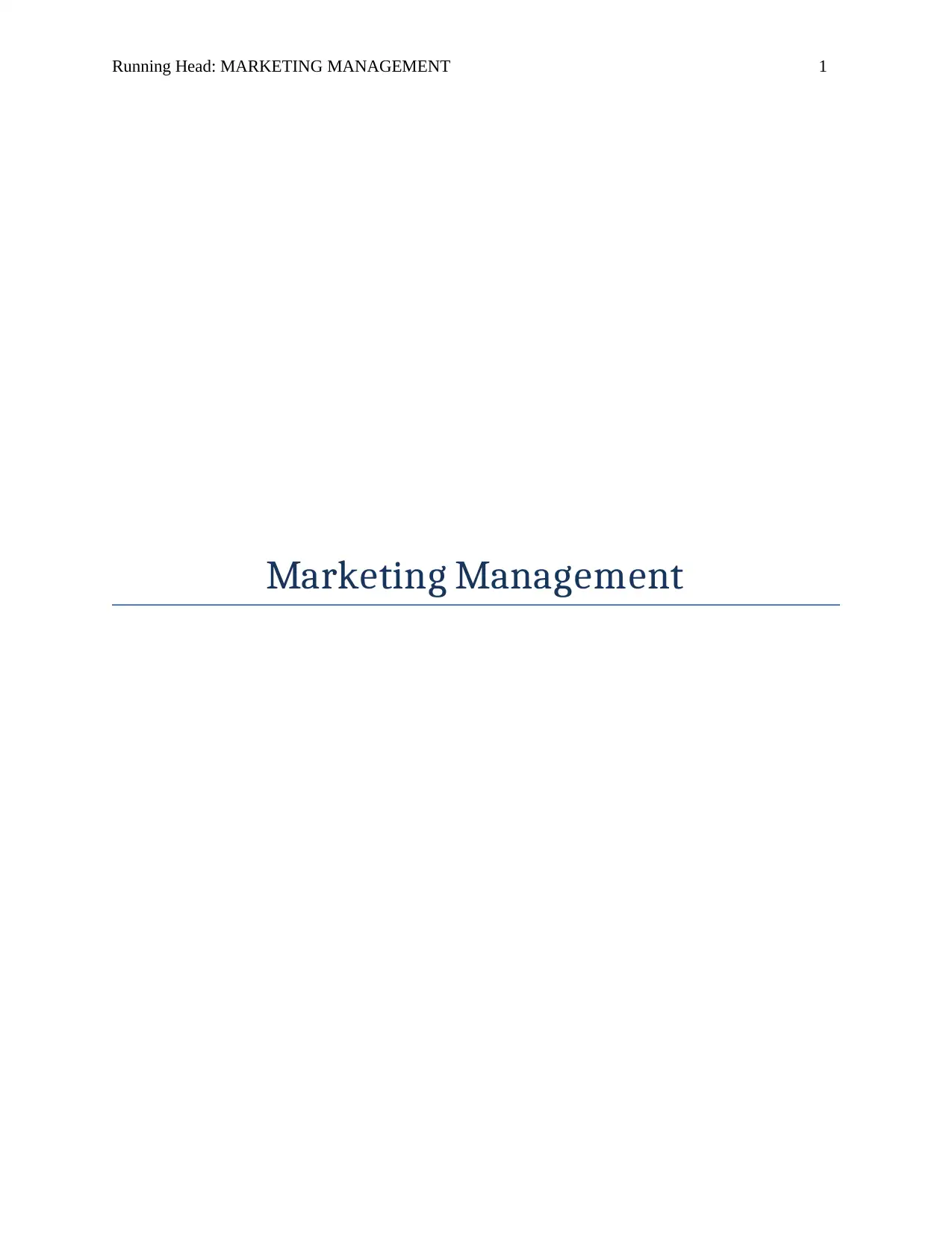
Running Head: MARKETING MANAGEMENT 1
Marketing Management
Marketing Management
Secure Best Marks with AI Grader
Need help grading? Try our AI Grader for instant feedback on your assignments.
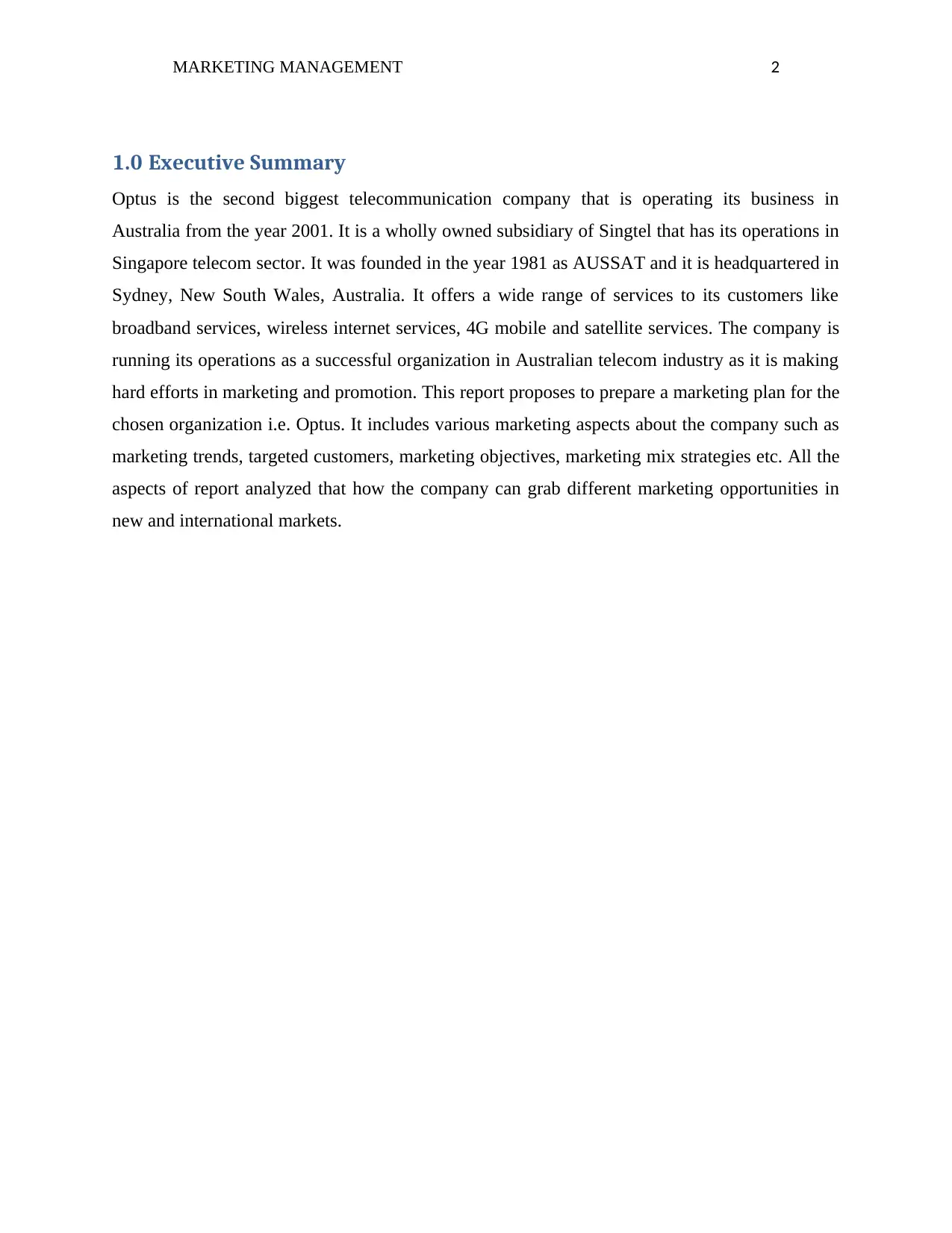
MARKETING MANAGEMENT 2
1.0 Executive Summary
Optus is the second biggest telecommunication company that is operating its business in
Australia from the year 2001. It is a wholly owned subsidiary of Singtel that has its operations in
Singapore telecom sector. It was founded in the year 1981 as AUSSAT and it is headquartered in
Sydney, New South Wales, Australia. It offers a wide range of services to its customers like
broadband services, wireless internet services, 4G mobile and satellite services. The company is
running its operations as a successful organization in Australian telecom industry as it is making
hard efforts in marketing and promotion. This report proposes to prepare a marketing plan for the
chosen organization i.e. Optus. It includes various marketing aspects about the company such as
marketing trends, targeted customers, marketing objectives, marketing mix strategies etc. All the
aspects of report analyzed that how the company can grab different marketing opportunities in
new and international markets.
1.0 Executive Summary
Optus is the second biggest telecommunication company that is operating its business in
Australia from the year 2001. It is a wholly owned subsidiary of Singtel that has its operations in
Singapore telecom sector. It was founded in the year 1981 as AUSSAT and it is headquartered in
Sydney, New South Wales, Australia. It offers a wide range of services to its customers like
broadband services, wireless internet services, 4G mobile and satellite services. The company is
running its operations as a successful organization in Australian telecom industry as it is making
hard efforts in marketing and promotion. This report proposes to prepare a marketing plan for the
chosen organization i.e. Optus. It includes various marketing aspects about the company such as
marketing trends, targeted customers, marketing objectives, marketing mix strategies etc. All the
aspects of report analyzed that how the company can grab different marketing opportunities in
new and international markets.
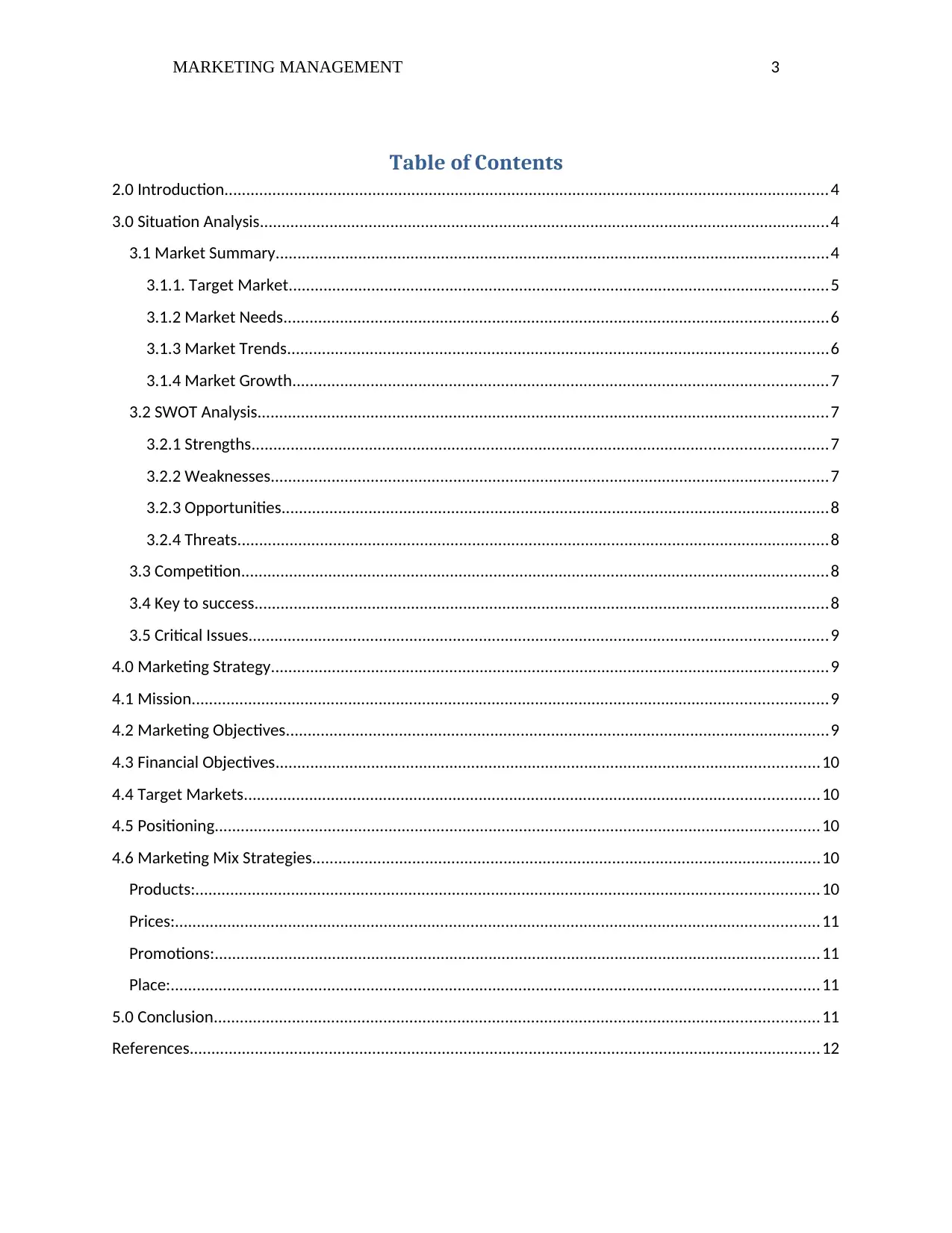
MARKETING MANAGEMENT 3
Table of Contents
2.0 Introduction...........................................................................................................................................4
3.0 Situation Analysis...................................................................................................................................4
3.1 Market Summary...............................................................................................................................4
3.1.1. Target Market............................................................................................................................5
3.1.2 Market Needs.............................................................................................................................6
3.1.3 Market Trends............................................................................................................................6
3.1.4 Market Growth...........................................................................................................................7
3.2 SWOT Analysis...................................................................................................................................7
3.2.1 Strengths....................................................................................................................................7
3.2.2 Weaknesses................................................................................................................................7
3.2.3 Opportunities..............................................................................................................................8
3.2.4 Threats........................................................................................................................................8
3.3 Competition.......................................................................................................................................8
3.4 Key to success....................................................................................................................................8
3.5 Critical Issues.....................................................................................................................................9
4.0 Marketing Strategy................................................................................................................................9
4.1 Mission..................................................................................................................................................9
4.2 Marketing Objectives.............................................................................................................................9
4.3 Financial Objectives.............................................................................................................................10
4.4 Target Markets....................................................................................................................................10
4.5 Positioning...........................................................................................................................................10
4.6 Marketing Mix Strategies.....................................................................................................................10
Products:...............................................................................................................................................10
Prices:....................................................................................................................................................11
Promotions:...........................................................................................................................................11
Place:.....................................................................................................................................................11
5.0 Conclusion...........................................................................................................................................11
References.................................................................................................................................................12
Table of Contents
2.0 Introduction...........................................................................................................................................4
3.0 Situation Analysis...................................................................................................................................4
3.1 Market Summary...............................................................................................................................4
3.1.1. Target Market............................................................................................................................5
3.1.2 Market Needs.............................................................................................................................6
3.1.3 Market Trends............................................................................................................................6
3.1.4 Market Growth...........................................................................................................................7
3.2 SWOT Analysis...................................................................................................................................7
3.2.1 Strengths....................................................................................................................................7
3.2.2 Weaknesses................................................................................................................................7
3.2.3 Opportunities..............................................................................................................................8
3.2.4 Threats........................................................................................................................................8
3.3 Competition.......................................................................................................................................8
3.4 Key to success....................................................................................................................................8
3.5 Critical Issues.....................................................................................................................................9
4.0 Marketing Strategy................................................................................................................................9
4.1 Mission..................................................................................................................................................9
4.2 Marketing Objectives.............................................................................................................................9
4.3 Financial Objectives.............................................................................................................................10
4.4 Target Markets....................................................................................................................................10
4.5 Positioning...........................................................................................................................................10
4.6 Marketing Mix Strategies.....................................................................................................................10
Products:...............................................................................................................................................10
Prices:....................................................................................................................................................11
Promotions:...........................................................................................................................................11
Place:.....................................................................................................................................................11
5.0 Conclusion...........................................................................................................................................11
References.................................................................................................................................................12

MARKETING MANAGEMENT 4
Secure Best Marks with AI Grader
Need help grading? Try our AI Grader for instant feedback on your assignments.

MARKETING MANAGEMENT 5
2.0 Introduction
Formulation of marketing plan is a significant document that is developed by each and every
organization when it plans to introduce its new products and services in the marketplace. It
includes different marketing strategies and techniques which support a company to promote its
products and attract customers towards its products and services. The objective of this report is to
develop a marketing plan for the chosen organization i.e. Optus. Optus is one of the largest
telecommunication organizations in Australia. The organization is operating its business as
wh/82olly owned subsidiary of Singtel from the year 2001. Primarily, it operates under Optus
brand when managing many subsidiaries, like Virgin Mobile Australia in telephony market. To
offer its services, Optus runs and owns its network infrastructure and utilizes the wholesale
services of Telstra and NBN (National Broadband Network) (Optus, 2018).
Moreover, it offers services directly to the final subscribers and it also works as wholesaler to
other firms like Amaysim and Exetel. Through its brand i.e. Yes, the company offers wireless
internet and broadband services. Additionally, its wholesale services are 4G Mobile and Satellite.
This report includes different components of marketing plan like market summary, situational
analysis and marketing strategy. Marketing strategies are identified by using the marketing mix
framework that includes all the strategies such as product, price, place and promotion strategies.
3.0 Situation Analysis
Optus is planning to expand its telecommunication and internet services in international market
i.e. New Zealand. In this process, marketing will be a key process for developing this brand and
increase its presence in international market. It will help the organization to increase its customer
base in Australian and other markets. Situational analysis and marketing analysis of Optus
Organization is stated below:
3.1 Market Summary
Under this component of marketing plan, Optus will gain the information about overall market
and characteristics of different customers on which it will target its services. This data will be
2.0 Introduction
Formulation of marketing plan is a significant document that is developed by each and every
organization when it plans to introduce its new products and services in the marketplace. It
includes different marketing strategies and techniques which support a company to promote its
products and attract customers towards its products and services. The objective of this report is to
develop a marketing plan for the chosen organization i.e. Optus. Optus is one of the largest
telecommunication organizations in Australia. The organization is operating its business as
wh/82olly owned subsidiary of Singtel from the year 2001. Primarily, it operates under Optus
brand when managing many subsidiaries, like Virgin Mobile Australia in telephony market. To
offer its services, Optus runs and owns its network infrastructure and utilizes the wholesale
services of Telstra and NBN (National Broadband Network) (Optus, 2018).
Moreover, it offers services directly to the final subscribers and it also works as wholesaler to
other firms like Amaysim and Exetel. Through its brand i.e. Yes, the company offers wireless
internet and broadband services. Additionally, its wholesale services are 4G Mobile and Satellite.
This report includes different components of marketing plan like market summary, situational
analysis and marketing strategy. Marketing strategies are identified by using the marketing mix
framework that includes all the strategies such as product, price, place and promotion strategies.
3.0 Situation Analysis
Optus is planning to expand its telecommunication and internet services in international market
i.e. New Zealand. In this process, marketing will be a key process for developing this brand and
increase its presence in international market. It will help the organization to increase its customer
base in Australian and other markets. Situational analysis and marketing analysis of Optus
Organization is stated below:
3.1 Market Summary
Under this component of marketing plan, Optus will gain the information about overall market
and characteristics of different customers on which it will target its services. This data will be
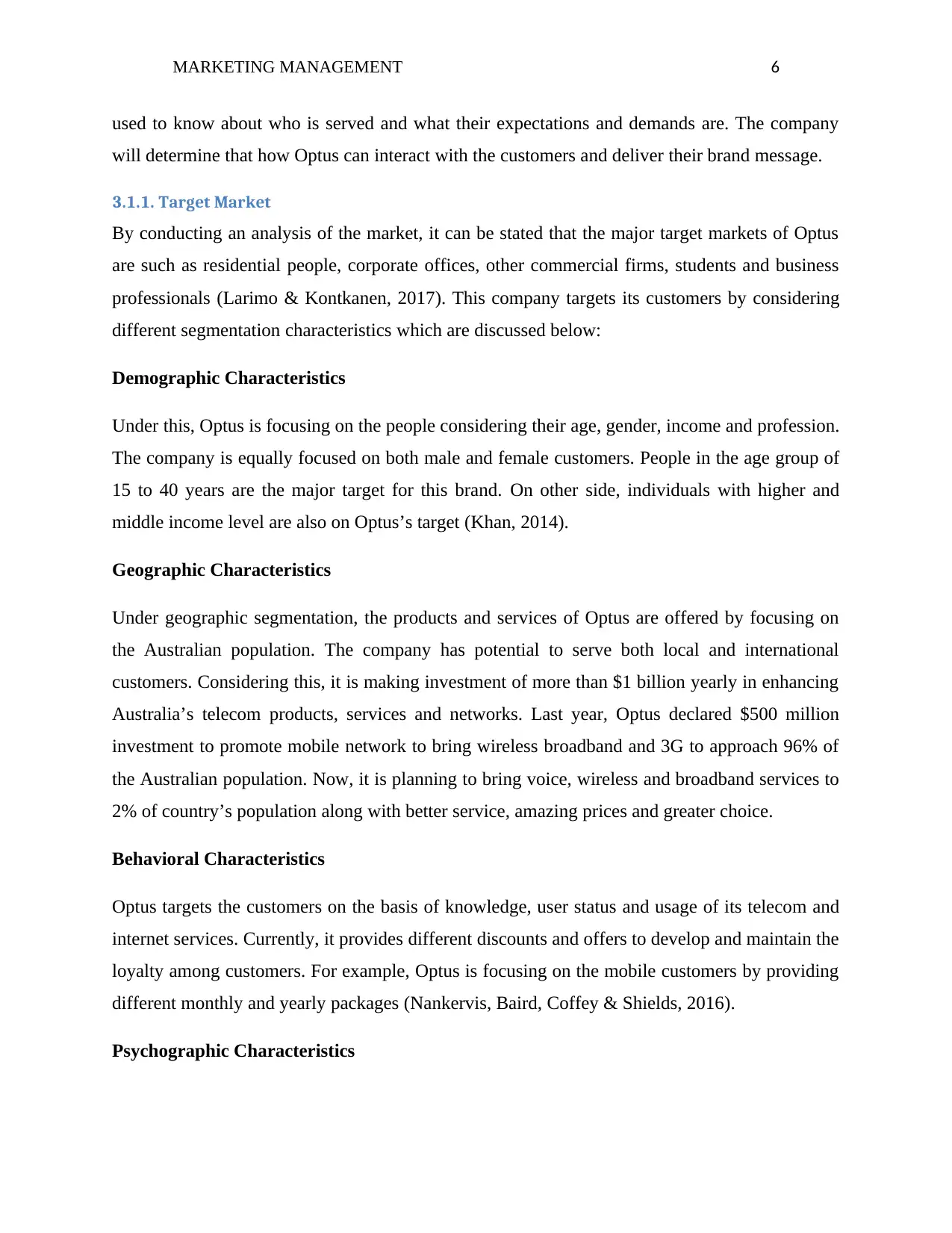
MARKETING MANAGEMENT 6
used to know about who is served and what their expectations and demands are. The company
will determine that how Optus can interact with the customers and deliver their brand message.
3.1.1. Target Market
By conducting an analysis of the market, it can be stated that the major target markets of Optus
are such as residential people, corporate offices, other commercial firms, students and business
professionals (Larimo & Kontkanen, 2017). This company targets its customers by considering
different segmentation characteristics which are discussed below:
Demographic Characteristics
Under this, Optus is focusing on the people considering their age, gender, income and profession.
The company is equally focused on both male and female customers. People in the age group of
15 to 40 years are the major target for this brand. On other side, individuals with higher and
middle income level are also on Optus’s target (Khan, 2014).
Geographic Characteristics
Under geographic segmentation, the products and services of Optus are offered by focusing on
the Australian population. The company has potential to serve both local and international
customers. Considering this, it is making investment of more than $1 billion yearly in enhancing
Australia’s telecom products, services and networks. Last year, Optus declared $500 million
investment to promote mobile network to bring wireless broadband and 3G to approach 96% of
the Australian population. Now, it is planning to bring voice, wireless and broadband services to
2% of country’s population along with better service, amazing prices and greater choice.
Behavioral Characteristics
Optus targets the customers on the basis of knowledge, user status and usage of its telecom and
internet services. Currently, it provides different discounts and offers to develop and maintain the
loyalty among customers. For example, Optus is focusing on the mobile customers by providing
different monthly and yearly packages (Nankervis, Baird, Coffey & Shields, 2016).
Psychographic Characteristics
used to know about who is served and what their expectations and demands are. The company
will determine that how Optus can interact with the customers and deliver their brand message.
3.1.1. Target Market
By conducting an analysis of the market, it can be stated that the major target markets of Optus
are such as residential people, corporate offices, other commercial firms, students and business
professionals (Larimo & Kontkanen, 2017). This company targets its customers by considering
different segmentation characteristics which are discussed below:
Demographic Characteristics
Under this, Optus is focusing on the people considering their age, gender, income and profession.
The company is equally focused on both male and female customers. People in the age group of
15 to 40 years are the major target for this brand. On other side, individuals with higher and
middle income level are also on Optus’s target (Khan, 2014).
Geographic Characteristics
Under geographic segmentation, the products and services of Optus are offered by focusing on
the Australian population. The company has potential to serve both local and international
customers. Considering this, it is making investment of more than $1 billion yearly in enhancing
Australia’s telecom products, services and networks. Last year, Optus declared $500 million
investment to promote mobile network to bring wireless broadband and 3G to approach 96% of
the Australian population. Now, it is planning to bring voice, wireless and broadband services to
2% of country’s population along with better service, amazing prices and greater choice.
Behavioral Characteristics
Optus targets the customers on the basis of knowledge, user status and usage of its telecom and
internet services. Currently, it provides different discounts and offers to develop and maintain the
loyalty among customers. For example, Optus is focusing on the mobile customers by providing
different monthly and yearly packages (Nankervis, Baird, Coffey & Shields, 2016).
Psychographic Characteristics
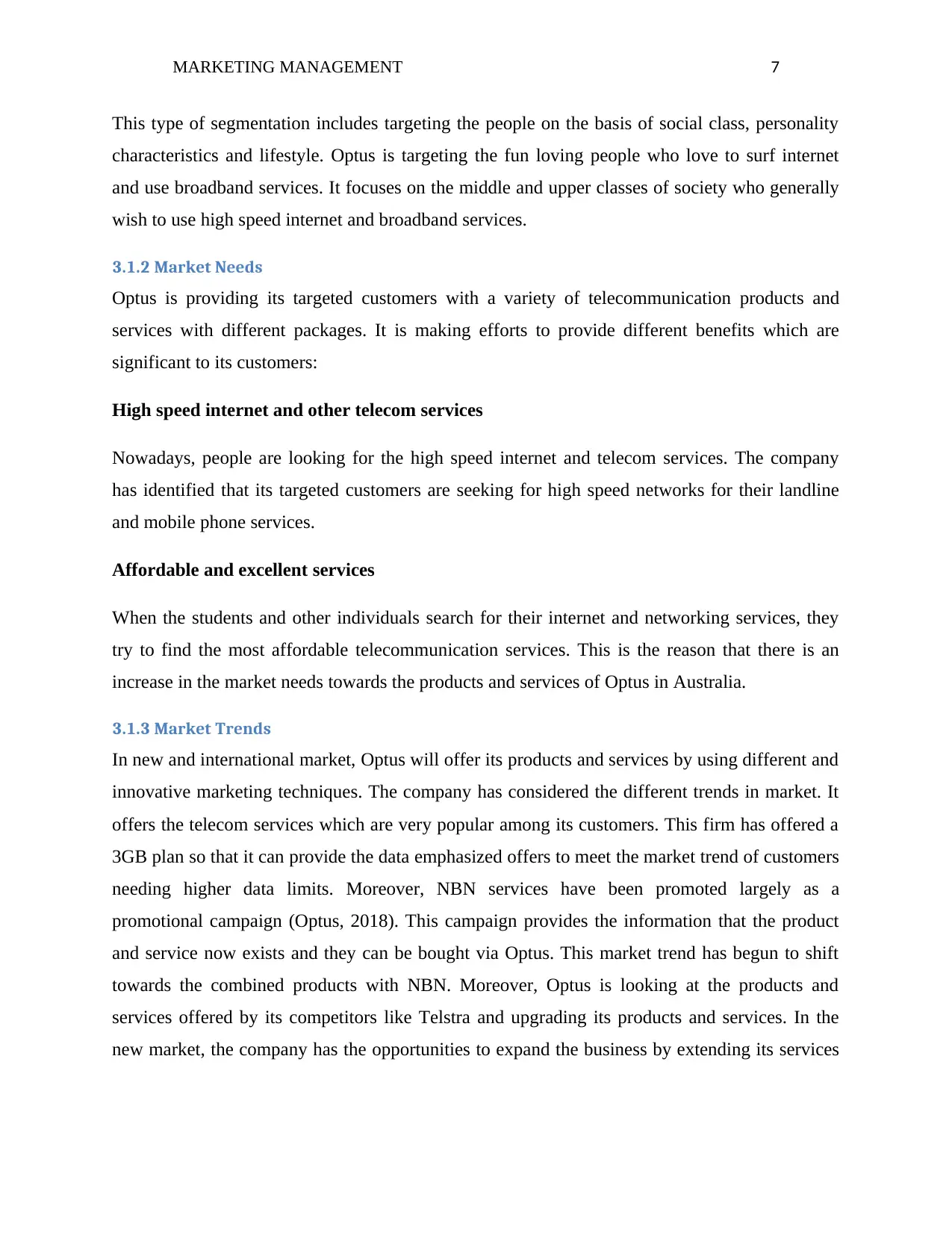
MARKETING MANAGEMENT 7
This type of segmentation includes targeting the people on the basis of social class, personality
characteristics and lifestyle. Optus is targeting the fun loving people who love to surf internet
and use broadband services. It focuses on the middle and upper classes of society who generally
wish to use high speed internet and broadband services.
3.1.2 Market Needs
Optus is providing its targeted customers with a variety of telecommunication products and
services with different packages. It is making efforts to provide different benefits which are
significant to its customers:
High speed internet and other telecom services
Nowadays, people are looking for the high speed internet and telecom services. The company
has identified that its targeted customers are seeking for high speed networks for their landline
and mobile phone services.
Affordable and excellent services
When the students and other individuals search for their internet and networking services, they
try to find the most affordable telecommunication services. This is the reason that there is an
increase in the market needs towards the products and services of Optus in Australia.
3.1.3 Market Trends
In new and international market, Optus will offer its products and services by using different and
innovative marketing techniques. The company has considered the different trends in market. It
offers the telecom services which are very popular among its customers. This firm has offered a
3GB plan so that it can provide the data emphasized offers to meet the market trend of customers
needing higher data limits. Moreover, NBN services have been promoted largely as a
promotional campaign (Optus, 2018). This campaign provides the information that the product
and service now exists and they can be bought via Optus. This market trend has begun to shift
towards the combined products with NBN. Moreover, Optus is looking at the products and
services offered by its competitors like Telstra and upgrading its products and services. In the
new market, the company has the opportunities to expand the business by extending its services
This type of segmentation includes targeting the people on the basis of social class, personality
characteristics and lifestyle. Optus is targeting the fun loving people who love to surf internet
and use broadband services. It focuses on the middle and upper classes of society who generally
wish to use high speed internet and broadband services.
3.1.2 Market Needs
Optus is providing its targeted customers with a variety of telecommunication products and
services with different packages. It is making efforts to provide different benefits which are
significant to its customers:
High speed internet and other telecom services
Nowadays, people are looking for the high speed internet and telecom services. The company
has identified that its targeted customers are seeking for high speed networks for their landline
and mobile phone services.
Affordable and excellent services
When the students and other individuals search for their internet and networking services, they
try to find the most affordable telecommunication services. This is the reason that there is an
increase in the market needs towards the products and services of Optus in Australia.
3.1.3 Market Trends
In new and international market, Optus will offer its products and services by using different and
innovative marketing techniques. The company has considered the different trends in market. It
offers the telecom services which are very popular among its customers. This firm has offered a
3GB plan so that it can provide the data emphasized offers to meet the market trend of customers
needing higher data limits. Moreover, NBN services have been promoted largely as a
promotional campaign (Optus, 2018). This campaign provides the information that the product
and service now exists and they can be bought via Optus. This market trend has begun to shift
towards the combined products with NBN. Moreover, Optus is looking at the products and
services offered by its competitors like Telstra and upgrading its products and services. In the
new market, the company has the opportunities to expand the business by extending its services
Paraphrase This Document
Need a fresh take? Get an instant paraphrase of this document with our AI Paraphraser
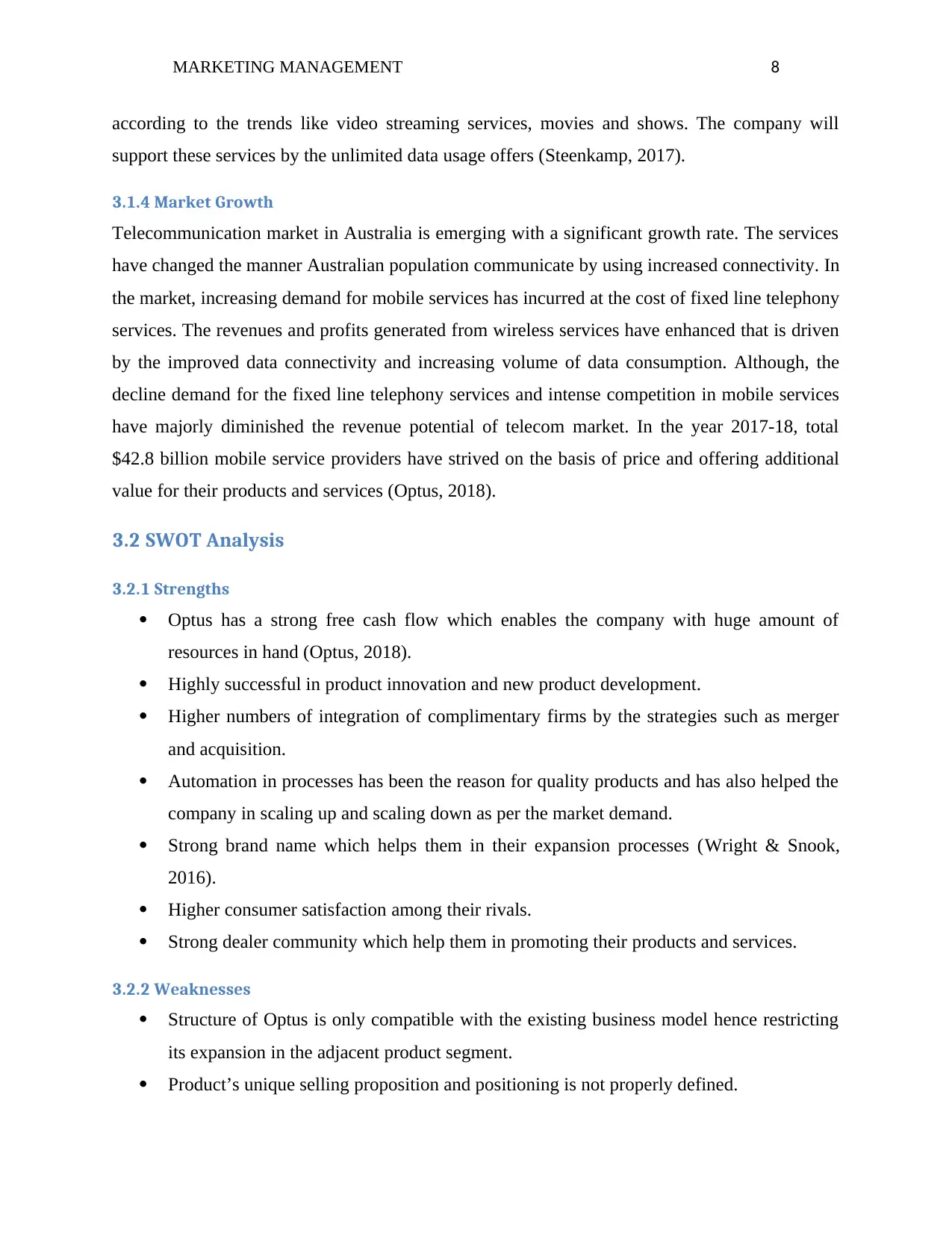
MARKETING MANAGEMENT 8
according to the trends like video streaming services, movies and shows. The company will
support these services by the unlimited data usage offers (Steenkamp, 2017).
3.1.4 Market Growth
Telecommunication market in Australia is emerging with a significant growth rate. The services
have changed the manner Australian population communicate by using increased connectivity. In
the market, increasing demand for mobile services has incurred at the cost of fixed line telephony
services. The revenues and profits generated from wireless services have enhanced that is driven
by the improved data connectivity and increasing volume of data consumption. Although, the
decline demand for the fixed line telephony services and intense competition in mobile services
have majorly diminished the revenue potential of telecom market. In the year 2017-18, total
$42.8 billion mobile service providers have strived on the basis of price and offering additional
value for their products and services (Optus, 2018).
3.2 SWOT Analysis
3.2.1 Strengths
Optus has a strong free cash flow which enables the company with huge amount of
resources in hand (Optus, 2018).
Highly successful in product innovation and new product development.
Higher numbers of integration of complimentary firms by the strategies such as merger
and acquisition.
Automation in processes has been the reason for quality products and has also helped the
company in scaling up and scaling down as per the market demand.
Strong brand name which helps them in their expansion processes (Wright & Snook,
2016).
Higher consumer satisfaction among their rivals.
Strong dealer community which help them in promoting their products and services.
3.2.2 Weaknesses
Structure of Optus is only compatible with the existing business model hence restricting
its expansion in the adjacent product segment.
Product’s unique selling proposition and positioning is not properly defined.
according to the trends like video streaming services, movies and shows. The company will
support these services by the unlimited data usage offers (Steenkamp, 2017).
3.1.4 Market Growth
Telecommunication market in Australia is emerging with a significant growth rate. The services
have changed the manner Australian population communicate by using increased connectivity. In
the market, increasing demand for mobile services has incurred at the cost of fixed line telephony
services. The revenues and profits generated from wireless services have enhanced that is driven
by the improved data connectivity and increasing volume of data consumption. Although, the
decline demand for the fixed line telephony services and intense competition in mobile services
have majorly diminished the revenue potential of telecom market. In the year 2017-18, total
$42.8 billion mobile service providers have strived on the basis of price and offering additional
value for their products and services (Optus, 2018).
3.2 SWOT Analysis
3.2.1 Strengths
Optus has a strong free cash flow which enables the company with huge amount of
resources in hand (Optus, 2018).
Highly successful in product innovation and new product development.
Higher numbers of integration of complimentary firms by the strategies such as merger
and acquisition.
Automation in processes has been the reason for quality products and has also helped the
company in scaling up and scaling down as per the market demand.
Strong brand name which helps them in their expansion processes (Wright & Snook,
2016).
Higher consumer satisfaction among their rivals.
Strong dealer community which help them in promoting their products and services.
3.2.2 Weaknesses
Structure of Optus is only compatible with the existing business model hence restricting
its expansion in the adjacent product segment.
Product’s unique selling proposition and positioning is not properly defined.

MARKETING MANAGEMENT 9
Net Contribution percentage and profitability ratio is under the industry average.
3.2.3 Opportunities
Increase in customers spending and limited growth of the industry has given them with an
opportunity to capture larger market share.
Green drive by government gives them with an opportunity for procurement of their
products by the country (Perrone & Wodonga, 2015).
3.2.4 Threats
Irregularity in the supply of innovative products.
Difference in Liability laws in different parts of the world has led to different liability
claims for the company.
There is a very intense competition in the market.
3.3 Competition
In Australian telecommunication industry, Optus is facing intense competition as there are
various players who are competing on the basis of prices of products and services. In this market,
one of the biggest competitors is Telstra that offers similar services and maintained a great brand
image among customers. Apart from this, other competitors are Motorola Corp. and Macquarie
Telecom which pose competitive pressure on Optus Telecom (Kraus, Meier, Eggers, Bouncken
& Schuessler, 2016). Considering the competition, Optus has made efforts to launch new and
innovative technologies to become more competitive to Telstra and other players in the sector. In
New Zealand, there are various leading players like Vodafone New Zealand and TelstraClear
which may pose immense competition on Optus Company.
3.4 Key to success
There are various factors which support the success of Optus Company. One of the major
factors is that this company is offering its products as per the needs and demands of customers in
the country. Competitive pricing of Optus is the biggest success factors that assist it to manage
its operational costs and introduce new services frequently. In addition to this, this organization
is making investment in improving infrastructure which enables it to achieve the technological
edge. If the company will be able to maintain these key to success factors, it will attain
significant growth and success in international markets (Fernandes, 2018).
Net Contribution percentage and profitability ratio is under the industry average.
3.2.3 Opportunities
Increase in customers spending and limited growth of the industry has given them with an
opportunity to capture larger market share.
Green drive by government gives them with an opportunity for procurement of their
products by the country (Perrone & Wodonga, 2015).
3.2.4 Threats
Irregularity in the supply of innovative products.
Difference in Liability laws in different parts of the world has led to different liability
claims for the company.
There is a very intense competition in the market.
3.3 Competition
In Australian telecommunication industry, Optus is facing intense competition as there are
various players who are competing on the basis of prices of products and services. In this market,
one of the biggest competitors is Telstra that offers similar services and maintained a great brand
image among customers. Apart from this, other competitors are Motorola Corp. and Macquarie
Telecom which pose competitive pressure on Optus Telecom (Kraus, Meier, Eggers, Bouncken
& Schuessler, 2016). Considering the competition, Optus has made efforts to launch new and
innovative technologies to become more competitive to Telstra and other players in the sector. In
New Zealand, there are various leading players like Vodafone New Zealand and TelstraClear
which may pose immense competition on Optus Company.
3.4 Key to success
There are various factors which support the success of Optus Company. One of the major
factors is that this company is offering its products as per the needs and demands of customers in
the country. Competitive pricing of Optus is the biggest success factors that assist it to manage
its operational costs and introduce new services frequently. In addition to this, this organization
is making investment in improving infrastructure which enables it to achieve the technological
edge. If the company will be able to maintain these key to success factors, it will attain
significant growth and success in international markets (Fernandes, 2018).
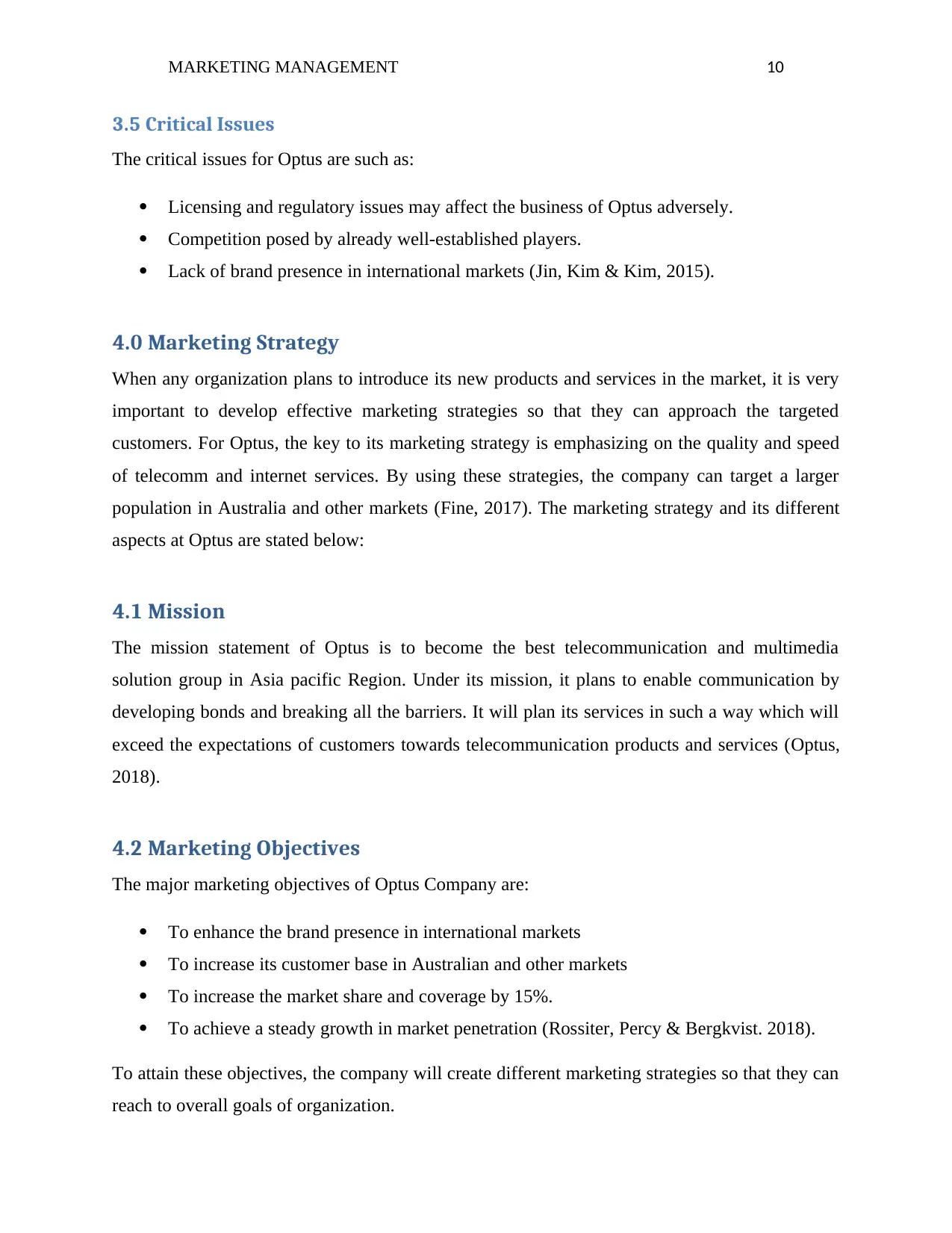
MARKETING MANAGEMENT 10
3.5 Critical Issues
The critical issues for Optus are such as:
Licensing and regulatory issues may affect the business of Optus adversely.
Competition posed by already well-established players.
Lack of brand presence in international markets (Jin, Kim & Kim, 2015).
4.0 Marketing Strategy
When any organization plans to introduce its new products and services in the market, it is very
important to develop effective marketing strategies so that they can approach the targeted
customers. For Optus, the key to its marketing strategy is emphasizing on the quality and speed
of telecomm and internet services. By using these strategies, the company can target a larger
population in Australia and other markets (Fine, 2017). The marketing strategy and its different
aspects at Optus are stated below:
4.1 Mission
The mission statement of Optus is to become the best telecommunication and multimedia
solution group in Asia pacific Region. Under its mission, it plans to enable communication by
developing bonds and breaking all the barriers. It will plan its services in such a way which will
exceed the expectations of customers towards telecommunication products and services (Optus,
2018).
4.2 Marketing Objectives
The major marketing objectives of Optus Company are:
To enhance the brand presence in international markets
To increase its customer base in Australian and other markets
To increase the market share and coverage by 15%.
To achieve a steady growth in market penetration (Rossiter, Percy & Bergkvist. 2018).
To attain these objectives, the company will create different marketing strategies so that they can
reach to overall goals of organization.
3.5 Critical Issues
The critical issues for Optus are such as:
Licensing and regulatory issues may affect the business of Optus adversely.
Competition posed by already well-established players.
Lack of brand presence in international markets (Jin, Kim & Kim, 2015).
4.0 Marketing Strategy
When any organization plans to introduce its new products and services in the market, it is very
important to develop effective marketing strategies so that they can approach the targeted
customers. For Optus, the key to its marketing strategy is emphasizing on the quality and speed
of telecomm and internet services. By using these strategies, the company can target a larger
population in Australia and other markets (Fine, 2017). The marketing strategy and its different
aspects at Optus are stated below:
4.1 Mission
The mission statement of Optus is to become the best telecommunication and multimedia
solution group in Asia pacific Region. Under its mission, it plans to enable communication by
developing bonds and breaking all the barriers. It will plan its services in such a way which will
exceed the expectations of customers towards telecommunication products and services (Optus,
2018).
4.2 Marketing Objectives
The major marketing objectives of Optus Company are:
To enhance the brand presence in international markets
To increase its customer base in Australian and other markets
To increase the market share and coverage by 15%.
To achieve a steady growth in market penetration (Rossiter, Percy & Bergkvist. 2018).
To attain these objectives, the company will create different marketing strategies so that they can
reach to overall goals of organization.
Secure Best Marks with AI Grader
Need help grading? Try our AI Grader for instant feedback on your assignments.

MARKETING MANAGEMENT 11
4.3 Financial Objectives
For this marketing plan, financial objectives of Optus Company are:
To increase its revenues and profits by 15% in the timeframe of next 3 years.
To maintain the investment of research and development for future development of
products.
To attain a significant growth rate in next three years.
4.4 Target Markets
As mentioned above, the company will target the customers on the basis of different
segmentation characteristics like demographic, geographic and behavioral characteristics. In
New Zealand market, Optus will be focusing on both the males and females of 15 to 40 years. It
will conduct a market research and analyze the number of customers who prefer to use internet
and other packages on affordable prices. The prices of Optus are slightly higher so it will focus
on the people of higher and middle income level (Davari & Strutton, 2014).
4.5 Positioning
Optus will position itself as a quality and excellent telecommunication service provider in New
Zealand. This positioning will be attained by leveraging the competitive advantage over other
players in the industry. In this market, the company will reduce the prices of its packages so that
it can attract more customers towards its telecom products and services (Helm & Gritsch, 2014).
4.6 Marketing Mix Strategies
This is an essential component of the today’s market and distinguishes their marketing from that
of others (Baker, 2014).
Products:
Optus is providing different types of Internet and broad band services along with the fixed and
mobile telephony (Optus, 2018). The services of the company are of high standards and the
chances of its success in the New Zealand market are very high. Apart from this it also gives
services such as cable television and leased line services.
4.3 Financial Objectives
For this marketing plan, financial objectives of Optus Company are:
To increase its revenues and profits by 15% in the timeframe of next 3 years.
To maintain the investment of research and development for future development of
products.
To attain a significant growth rate in next three years.
4.4 Target Markets
As mentioned above, the company will target the customers on the basis of different
segmentation characteristics like demographic, geographic and behavioral characteristics. In
New Zealand market, Optus will be focusing on both the males and females of 15 to 40 years. It
will conduct a market research and analyze the number of customers who prefer to use internet
and other packages on affordable prices. The prices of Optus are slightly higher so it will focus
on the people of higher and middle income level (Davari & Strutton, 2014).
4.5 Positioning
Optus will position itself as a quality and excellent telecommunication service provider in New
Zealand. This positioning will be attained by leveraging the competitive advantage over other
players in the industry. In this market, the company will reduce the prices of its packages so that
it can attract more customers towards its telecom products and services (Helm & Gritsch, 2014).
4.6 Marketing Mix Strategies
This is an essential component of the today’s market and distinguishes their marketing from that
of others (Baker, 2014).
Products:
Optus is providing different types of Internet and broad band services along with the fixed and
mobile telephony (Optus, 2018). The services of the company are of high standards and the
chances of its success in the New Zealand market are very high. Apart from this it also gives
services such as cable television and leased line services.
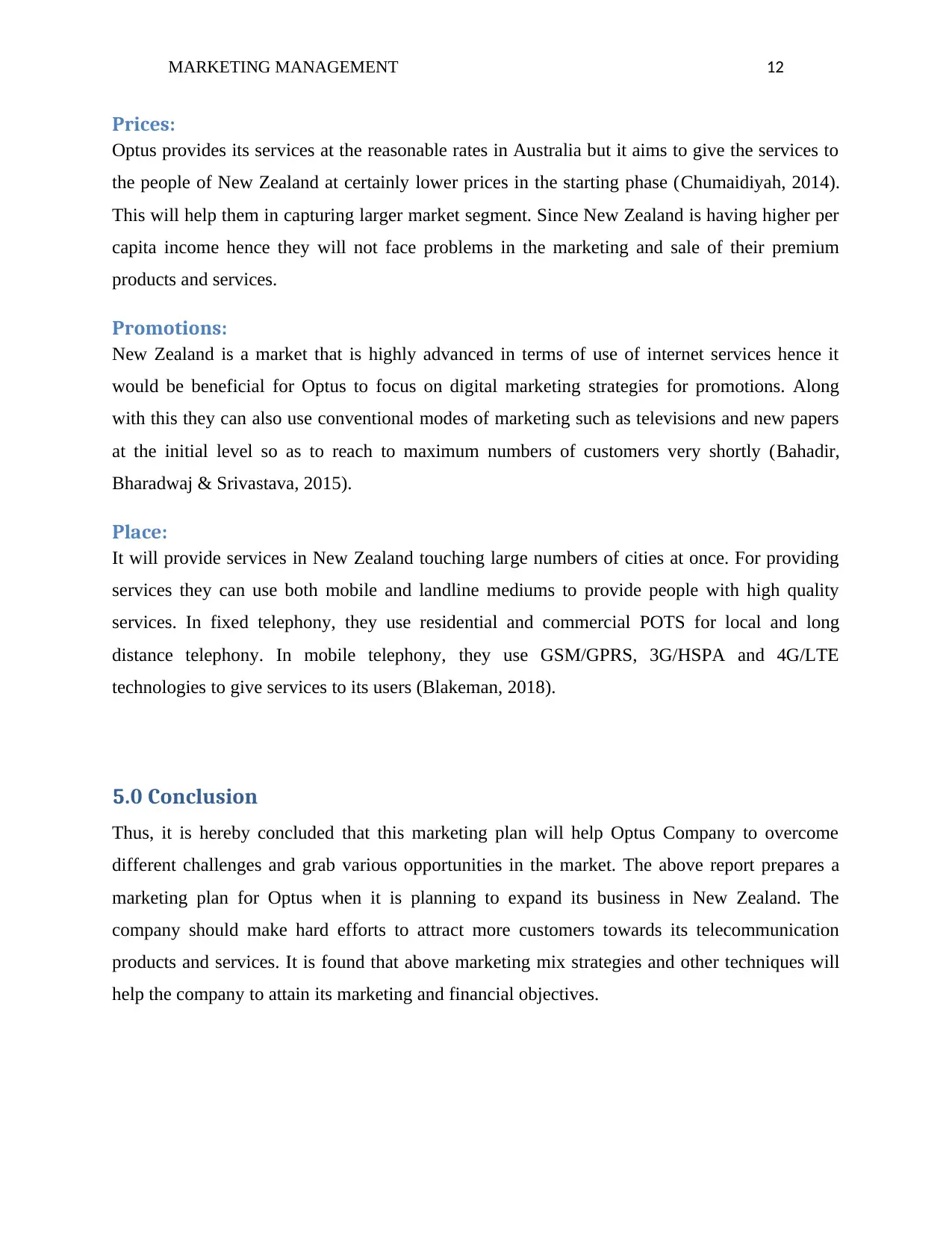
MARKETING MANAGEMENT 12
Prices:
Optus provides its services at the reasonable rates in Australia but it aims to give the services to
the people of New Zealand at certainly lower prices in the starting phase (Chumaidiyah, 2014).
This will help them in capturing larger market segment. Since New Zealand is having higher per
capita income hence they will not face problems in the marketing and sale of their premium
products and services.
Promotions:
New Zealand is a market that is highly advanced in terms of use of internet services hence it
would be beneficial for Optus to focus on digital marketing strategies for promotions. Along
with this they can also use conventional modes of marketing such as televisions and new papers
at the initial level so as to reach to maximum numbers of customers very shortly (Bahadir,
Bharadwaj & Srivastava, 2015).
Place:
It will provide services in New Zealand touching large numbers of cities at once. For providing
services they can use both mobile and landline mediums to provide people with high quality
services. In fixed telephony, they use residential and commercial POTS for local and long
distance telephony. In mobile telephony, they use GSM/GPRS, 3G/HSPA and 4G/LTE
technologies to give services to its users (Blakeman, 2018).
5.0 Conclusion
Thus, it is hereby concluded that this marketing plan will help Optus Company to overcome
different challenges and grab various opportunities in the market. The above report prepares a
marketing plan for Optus when it is planning to expand its business in New Zealand. The
company should make hard efforts to attract more customers towards its telecommunication
products and services. It is found that above marketing mix strategies and other techniques will
help the company to attain its marketing and financial objectives.
Prices:
Optus provides its services at the reasonable rates in Australia but it aims to give the services to
the people of New Zealand at certainly lower prices in the starting phase (Chumaidiyah, 2014).
This will help them in capturing larger market segment. Since New Zealand is having higher per
capita income hence they will not face problems in the marketing and sale of their premium
products and services.
Promotions:
New Zealand is a market that is highly advanced in terms of use of internet services hence it
would be beneficial for Optus to focus on digital marketing strategies for promotions. Along
with this they can also use conventional modes of marketing such as televisions and new papers
at the initial level so as to reach to maximum numbers of customers very shortly (Bahadir,
Bharadwaj & Srivastava, 2015).
Place:
It will provide services in New Zealand touching large numbers of cities at once. For providing
services they can use both mobile and landline mediums to provide people with high quality
services. In fixed telephony, they use residential and commercial POTS for local and long
distance telephony. In mobile telephony, they use GSM/GPRS, 3G/HSPA and 4G/LTE
technologies to give services to its users (Blakeman, 2018).
5.0 Conclusion
Thus, it is hereby concluded that this marketing plan will help Optus Company to overcome
different challenges and grab various opportunities in the market. The above report prepares a
marketing plan for Optus when it is planning to expand its business in New Zealand. The
company should make hard efforts to attract more customers towards its telecommunication
products and services. It is found that above marketing mix strategies and other techniques will
help the company to attain its marketing and financial objectives.
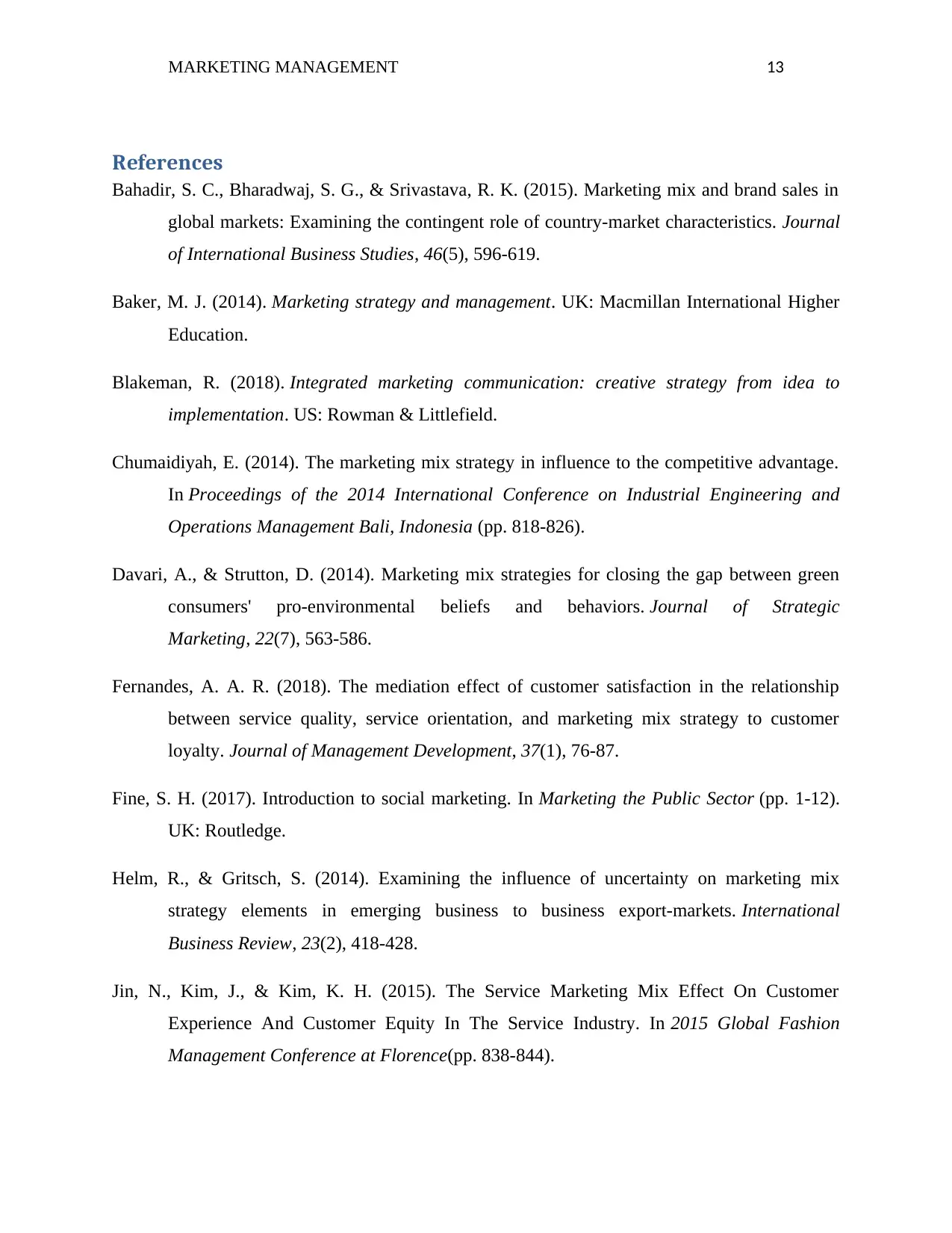
MARKETING MANAGEMENT 13
References
Bahadir, S. C., Bharadwaj, S. G., & Srivastava, R. K. (2015). Marketing mix and brand sales in
global markets: Examining the contingent role of country-market characteristics. Journal
of International Business Studies, 46(5), 596-619.
Baker, M. J. (2014). Marketing strategy and management. UK: Macmillan International Higher
Education.
Blakeman, R. (2018). Integrated marketing communication: creative strategy from idea to
implementation. US: Rowman & Littlefield.
Chumaidiyah, E. (2014). The marketing mix strategy in influence to the competitive advantage.
In Proceedings of the 2014 International Conference on Industrial Engineering and
Operations Management Bali, Indonesia (pp. 818-826).
Davari, A., & Strutton, D. (2014). Marketing mix strategies for closing the gap between green
consumers' pro-environmental beliefs and behaviors. Journal of Strategic
Marketing, 22(7), 563-586.
Fernandes, A. A. R. (2018). The mediation effect of customer satisfaction in the relationship
between service quality, service orientation, and marketing mix strategy to customer
loyalty. Journal of Management Development, 37(1), 76-87.
Fine, S. H. (2017). Introduction to social marketing. In Marketing the Public Sector (pp. 1-12).
UK: Routledge.
Helm, R., & Gritsch, S. (2014). Examining the influence of uncertainty on marketing mix
strategy elements in emerging business to business export-markets. International
Business Review, 23(2), 418-428.
Jin, N., Kim, J., & Kim, K. H. (2015). The Service Marketing Mix Effect On Customer
Experience And Customer Equity In The Service Industry. In 2015 Global Fashion
Management Conference at Florence(pp. 838-844).
References
Bahadir, S. C., Bharadwaj, S. G., & Srivastava, R. K. (2015). Marketing mix and brand sales in
global markets: Examining the contingent role of country-market characteristics. Journal
of International Business Studies, 46(5), 596-619.
Baker, M. J. (2014). Marketing strategy and management. UK: Macmillan International Higher
Education.
Blakeman, R. (2018). Integrated marketing communication: creative strategy from idea to
implementation. US: Rowman & Littlefield.
Chumaidiyah, E. (2014). The marketing mix strategy in influence to the competitive advantage.
In Proceedings of the 2014 International Conference on Industrial Engineering and
Operations Management Bali, Indonesia (pp. 818-826).
Davari, A., & Strutton, D. (2014). Marketing mix strategies for closing the gap between green
consumers' pro-environmental beliefs and behaviors. Journal of Strategic
Marketing, 22(7), 563-586.
Fernandes, A. A. R. (2018). The mediation effect of customer satisfaction in the relationship
between service quality, service orientation, and marketing mix strategy to customer
loyalty. Journal of Management Development, 37(1), 76-87.
Fine, S. H. (2017). Introduction to social marketing. In Marketing the Public Sector (pp. 1-12).
UK: Routledge.
Helm, R., & Gritsch, S. (2014). Examining the influence of uncertainty on marketing mix
strategy elements in emerging business to business export-markets. International
Business Review, 23(2), 418-428.
Jin, N., Kim, J., & Kim, K. H. (2015). The Service Marketing Mix Effect On Customer
Experience And Customer Equity In The Service Industry. In 2015 Global Fashion
Management Conference at Florence(pp. 838-844).
Paraphrase This Document
Need a fresh take? Get an instant paraphrase of this document with our AI Paraphraser
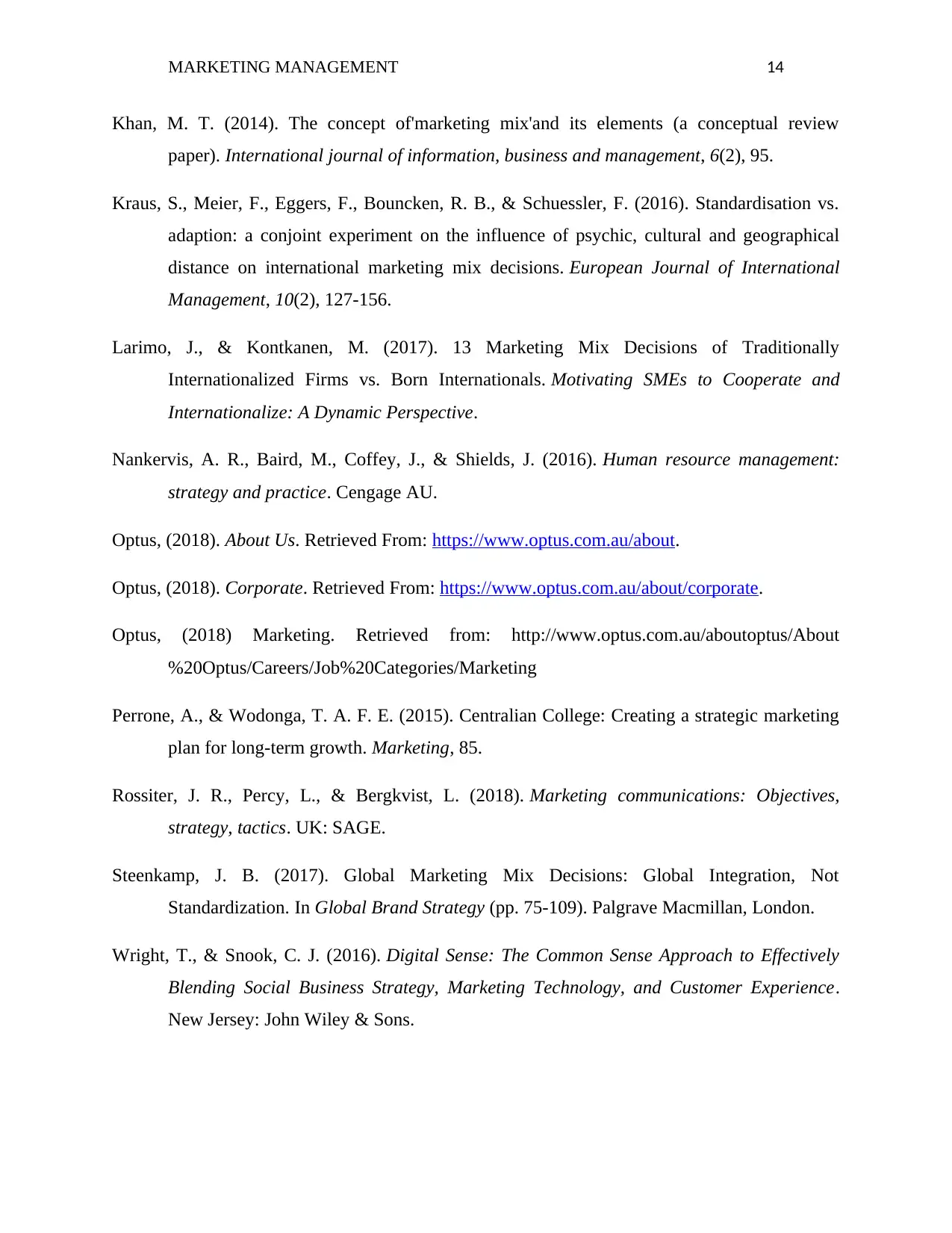
MARKETING MANAGEMENT 14
Khan, M. T. (2014). The concept of'marketing mix'and its elements (a conceptual review
paper). International journal of information, business and management, 6(2), 95.
Kraus, S., Meier, F., Eggers, F., Bouncken, R. B., & Schuessler, F. (2016). Standardisation vs.
adaption: a conjoint experiment on the influence of psychic, cultural and geographical
distance on international marketing mix decisions. European Journal of International
Management, 10(2), 127-156.
Larimo, J., & Kontkanen, M. (2017). 13 Marketing Mix Decisions of Traditionally
Internationalized Firms vs. Born Internationals. Motivating SMEs to Cooperate and
Internationalize: A Dynamic Perspective.
Nankervis, A. R., Baird, M., Coffey, J., & Shields, J. (2016). Human resource management:
strategy and practice. Cengage AU.
Optus, (2018). About Us. Retrieved From: https://www.optus.com.au/about.
Optus, (2018). Corporate. Retrieved From: https://www.optus.com.au/about/corporate.
Optus, (2018) Marketing. Retrieved from: http://www.optus.com.au/aboutoptus/About
%20Optus/Careers/Job%20Categories/Marketing
Perrone, A., & Wodonga, T. A. F. E. (2015). Centralian College: Creating a strategic marketing
plan for long-term growth. Marketing, 85.
Rossiter, J. R., Percy, L., & Bergkvist, L. (2018). Marketing communications: Objectives,
strategy, tactics. UK: SAGE.
Steenkamp, J. B. (2017). Global Marketing Mix Decisions: Global Integration, Not
Standardization. In Global Brand Strategy (pp. 75-109). Palgrave Macmillan, London.
Wright, T., & Snook, C. J. (2016). Digital Sense: The Common Sense Approach to Effectively
Blending Social Business Strategy, Marketing Technology, and Customer Experience.
New Jersey: John Wiley & Sons.
Khan, M. T. (2014). The concept of'marketing mix'and its elements (a conceptual review
paper). International journal of information, business and management, 6(2), 95.
Kraus, S., Meier, F., Eggers, F., Bouncken, R. B., & Schuessler, F. (2016). Standardisation vs.
adaption: a conjoint experiment on the influence of psychic, cultural and geographical
distance on international marketing mix decisions. European Journal of International
Management, 10(2), 127-156.
Larimo, J., & Kontkanen, M. (2017). 13 Marketing Mix Decisions of Traditionally
Internationalized Firms vs. Born Internationals. Motivating SMEs to Cooperate and
Internationalize: A Dynamic Perspective.
Nankervis, A. R., Baird, M., Coffey, J., & Shields, J. (2016). Human resource management:
strategy and practice. Cengage AU.
Optus, (2018). About Us. Retrieved From: https://www.optus.com.au/about.
Optus, (2018). Corporate. Retrieved From: https://www.optus.com.au/about/corporate.
Optus, (2018) Marketing. Retrieved from: http://www.optus.com.au/aboutoptus/About
%20Optus/Careers/Job%20Categories/Marketing
Perrone, A., & Wodonga, T. A. F. E. (2015). Centralian College: Creating a strategic marketing
plan for long-term growth. Marketing, 85.
Rossiter, J. R., Percy, L., & Bergkvist, L. (2018). Marketing communications: Objectives,
strategy, tactics. UK: SAGE.
Steenkamp, J. B. (2017). Global Marketing Mix Decisions: Global Integration, Not
Standardization. In Global Brand Strategy (pp. 75-109). Palgrave Macmillan, London.
Wright, T., & Snook, C. J. (2016). Digital Sense: The Common Sense Approach to Effectively
Blending Social Business Strategy, Marketing Technology, and Customer Experience.
New Jersey: John Wiley & Sons.

MARKETING MANAGEMENT 15
1 out of 15
Related Documents
Your All-in-One AI-Powered Toolkit for Academic Success.
+13062052269
info@desklib.com
Available 24*7 on WhatsApp / Email
![[object Object]](/_next/static/media/star-bottom.7253800d.svg)
Unlock your academic potential
© 2024 | Zucol Services PVT LTD | All rights reserved.





